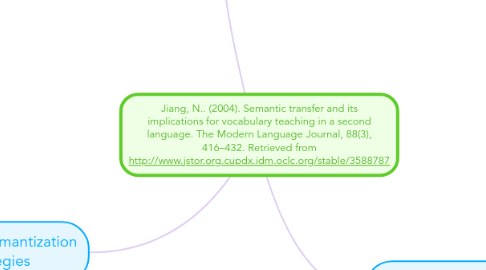
1. Unique learning conditions of adult learners
1.1. Adults often have less contextualized language input than younger individuals which makes lexical meanings difficult to comprehend
1.2. Adults possess a well-established conceptual and lexical system, so most L2 words have a corresponding concept and translation in the adult learner's L1.
1.3. adult L2 vocabulary acquisition is accompanied by little semantic development, but actively influenced by L1 linguistic system
2. Semantization Strategies
2.1. Intralingual strategies
2.1.1. use of linguistic means of the target language; use of comprehensible input (acquisition view)
2.1.1.1. Synonyms, definitions or in-context cues
2.2. Interlingual strategies
2.2.1. utilize the L1 to translate words in L2 (learning view)
2.2.1.1. bilingual dictionary, cognates, or L1 translation equivalents in the L2, often associated with word lists
2.3. Extralingual strategies
2.3.1. use non-verbal, language
2.3.1.1. make use of pictures, objects, physical contexts, and other multimedia aids
3. Three Stage Model of Adult Vocabulary Acquisition
3.1. Lexical Association Stage
3.1.1. Adult learners recognize orthographic or phonological form as a word. They understand the word's meaning within an existing semantic structure, which is closely linked to their L1. The learners associate the L2 word with its L1 translation.
3.2. L1 Lemma Mediation Stage
3.2.1. The transferred information links L2 words and concepts directly and mediates L2 use. Activation of L1 translation in L2 use decreases. Continued exposure to contextualized input may help develop new, L2-specific meanings.
3.3. Full Integration Stage
3.3.1. L2-specific information dominates L2 entries; strong links connect L2 words and concepts; morphological knowledge is integrated; lexical links between L2 words and their L1 translations weaken.
